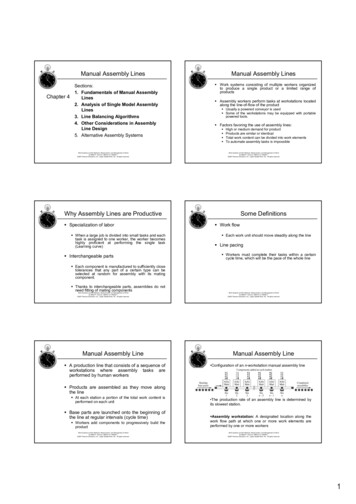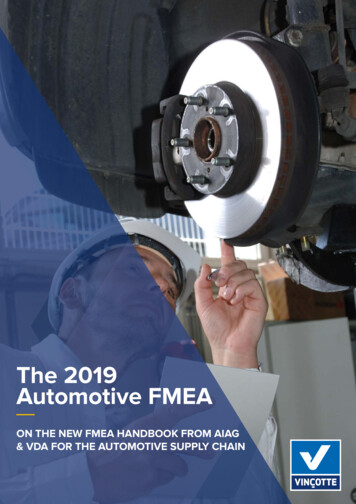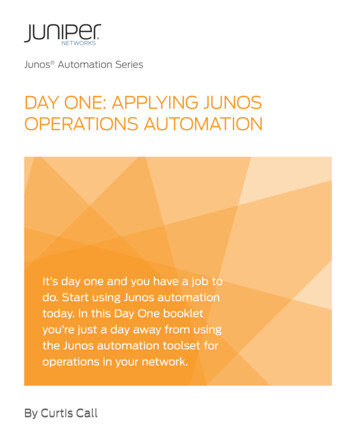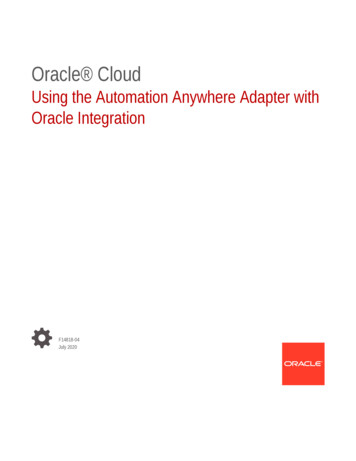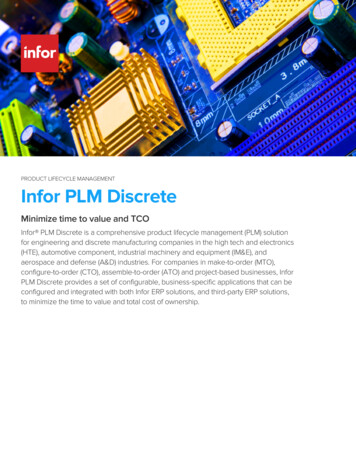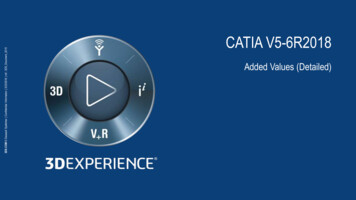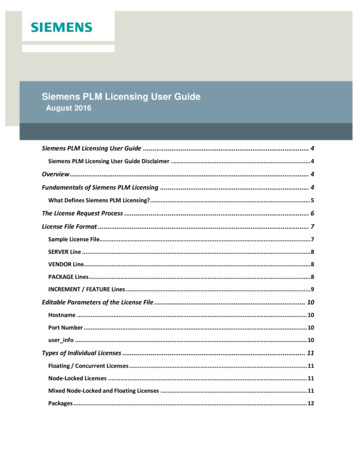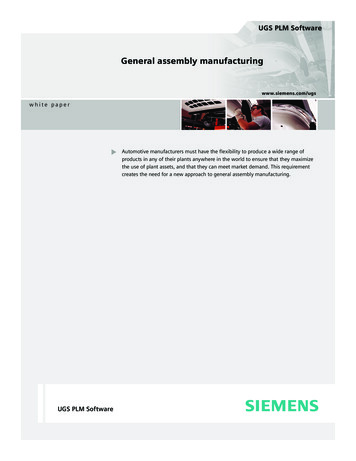
Transcription
UGS PLM SoftwareGeneral assembly manufacturingwww.siemens.com/ugswhite paperAutomotive manufacturers must have the flexibility to produce a wide range ofproducts in any of their plants anywhere in the world to ensure that they maximizethe use of plant assets, and that they can meet market demand. This requirementcreates the need for a new approach to general assembly manufacturing.UGS PLM Software
General assembly manufacturingTable of contentsExecutive summary1Introduction2Strategic manufacturing planning –Have you visualized your futureoperational needs?4Product development –Do manufacturing and productdevelopment really work together?5Manufacturing quoting andchange management –Are you making timely and accuratefinancial decisions?6Assembly process planning –Are you adequately optimizing andvalidating assembly processesbefore launch?7Plant design and optimization –Are you validating that your plantswill run efficiently before youbuild them?9Production execution –Are you capturing the informationyou need to accelerate continuousimprovement?10Summary11
Executive summaryFor both automotive OEMs and suppliers, today’s global environment presents manychallenges in planning the assembly process. Plants need to be flexible in their assemblycapabilities; at the same time they must operate at maximum efficiency. Cost and time-tomarket pressures also are factors, as competition forces margins lower and faster productdevelopment cycles can mean the difference between being the first or the last to market.The way process planning is executed today has to change. This includes all cross-functionalaspects of the planning process – from strategic manufacturing planning to productdevelopment, manufacturing quoting and change management, planning and validation,plant design and optimization and production execution. The effectiveness of the overallmanufacturing planning process is dependent on how well these aspects are linked andinteractively managed.Automotive companies’ primary barriers to effective manufacturing planning for generalassembly are: Inadequate synchronization between product and manufacturing engineering Wasted time and effort due to inadequate management of manufacturing data Insufficient ability to optimize and validate critical aspects of the manufacturing processprior to launch Inability to work collaboratively and manage change within a shared context Inability to manage manufacturing execution for continuous process improvement Lack of a precise, reliable way to estimate manufacturing costsIn order to remove these barriers, automotive companies are progressing towards digitalmanufacturing tools based on product lifecycle management, or PLM. These tools can helpcompanies remove the barriers to effective manufacturing planning, resulting in: Improved initial build quality Reduced development time On-time launch and delivery Improved capital utilization1
IntroductionIn order to have the most flexible and efficient production assembly capabilities, manufacturers must have the ability to continuously validate and optimize their manufacturingprocesses. This means that they also have to be prepared for the potential of assembling anyproduct in their portfolio at any plant anywhere in the world, and to be able to change theproduction mix quickly while still maintaining high quality.In the past, automotive OEMs and suppliers were able to focus their manufacturing plants ondedicated product lines or platforms. They produced and assembled the same set of productsyear after year. Today, there are many more products in the market, and demand for thoseproducts changes much more rapidly. The need to respond to changes in demand acrossglobal production capabilities presents a significant challenge for manufacturing engineering.In order to define and implement new manufacturing processes correctly, and to continuously improve manufacturing operations, manufacturing engineering must effectivelycollaborate with product engineering, procurement and plant operations. Tasks can no longerbe completed serially and process planning cannot be done independently of the otherfunctions. There are so many dependencies among them that they must work in parallel toshorten the overall product development time.Even as these groups try to work together, they struggle with some significant barriers toeffectively defining and validating the best possible processes. For example: Product development typically has little or no visibility into the manufacturing planningprocess. This makes it difficult to consider the impact their design decisions have on thecost to manufacture. The opposite holds true as manufacturing engineering has littlevisibility into development, and has trouble keeping track of changes in designs that mayhave significant cost ramifications. Often these costs aren’t discovered until the change hasbeen approved and implemented in development, and manufacturing has to address theproblem. In general, keeping manufacturing engineering and product developmentsynchronized is a challenge for most companies Information is hard to find. Knowledge about what’s been done before remains in theheads of those who did it. People either have to figure it out again, or locate the personwho did it the last time. This leads to a significant amount of wasted time and effort Just as physical prototypes of the product are tested and validated to ensure they performas planned, the manufacturing processes and plants need to be tested and validated tomake sure they function properly and as efficiently as possible. For most companies, thismeans prototyping the actual plant, fixtures and tooling. But how can that be done? It’s notfeasible to build a prototype plant; nor is it acceptable anymore to shut down a plant forweeks to “try out” the new tooling and processes. This is why there is so much anxietyaround launches on most product teams. No one fully knows what problems will occurbecause they don’t have the ability to optimize and validate all critical aspects of themanufacturing process prior to launch2
Understanding how the design affects others in the overall process is important, especiallywith the constant onslaught of design changes. In most companies, collaboration amongdepartments and the ability to design within the same assembly context isn’t possibleunless the engineers are physically present in a common location. To a great extent, today’sglobal structure with decentralized engineering centers and global suppliers makes thisextremely difficult Continuous process improvement is a must. Plant personnel apply Kaizen principles tothe assembly process on a daily basis, especially during the initial execution of a newproduct or process. However, in most cases, the knowledge of these fixes or best-in-classprocesses isn’t managed very well and doesn’t consistently get fed back into the assemblyplanning process Both OEMs and suppliers need a more precise and reliable way of estimating manufacturing cost, whether it’s for a new product program or understanding how a change willaffect the current assembly processIn order to make efficient use of the investment that manufacturers have made in their plantsand equipment, they must be able to meet varying demand by quickly changing the productsthat are produced at each manufacturing facility. However, it is extremely difficult to conductthe assembly planning process in a common, repeatable fashion, striving for as muchcommonality as possible while still allowing for flexibility and localization. This requires anenterprise approach to process planning for each product implemented at each plant,allowing for certain variations based on current production product mix, differences insuppliers, labor and other variables that must be considered. To create this enterprise view ofthe bill of process (BOP), companies must put tools and processes in place that allow anyonewho is affected by or contributes to the BOP to collaborate effectively on its creation andimplementation.Manufacturing Planning for General Assembly is a cross-functional activity that involvesnumerous processes across the company. This paper discusses those processes, including:Strategic manufacturing planning Manufacturing planning at the portfolio levelProduct development Providing early and accurate access to product design and bill of material information Maintaining alignment between evolving product and manufacturing process definitionsManufacturing quoting and change management Delivering accurate manufacturing cost estimates Managing change context for collaborative decision making Applying proactive tools for accurate impact assessmentAssembly process planning and validation Accurately defining and documenting manufacturing processes for all product variants Proactively optimizing and validating assembly processesPlant design and optimization Creating accurate digital representations of plants and resources Proactively optimizing and validating manufacturing facilities Optimizing and validating material distribution networksProduction execution Controlling execution quality Capturing information for continuous improvement3
Strategic manufacturing planningHave you visualized your future operational needs?The strategic manufacturing plan sets the direction for the future manufacturing approachthat will lead to a competitive advantage for the automotive manufacturer. Throughout theplanning process, manufacturing engineering must take many things into consideration. Thestrategic manufacturing plan not only requires input from product engineering on the newproduct, but also needs input from tooling suppliers on new and upcoming tooling andtechnologies, market segments, government requirements, local labor laws andenvironmental concerns. Manufacturers also must review their current assembly facilities anddecide whether or not it would be worthwhile to invest in updates or expansion.Most companies spend a significant amount of time planning their product portfolio. But howmany companies do the same with manufacturing? While many companies realize thisholistic view of portfolio planning is important, few are good at doing it today. In developingthe manufacturing strategic plan, manufacturers have difficulty: Designing and validating new manufacturing processes, tooling and techniques withoutbuilding physical prototypes of the manufacturing process. Building manufacturingprototypes becomes very expensive Getting physical prototype parts and assemblies from product engineering and supplierswhen they need them Accessing support data, such as future market segmentation and local labor lawsAutomotive companies that want to give themselves a competitive edge are creating a digitalmanufacturing environment to assist them in strategic, portfolio-level manufacturingplanning. This environment helps them by eliminating the lead time required to producemultiple versions of physical tooling prototypes. Physical prototype parts aren’t requiredeither, as the digital representation of the part can be used instead. New assembly processescan be validated within a digital representation of current and future facilities. Having ashared environment to manage the planning process also gives other organizations the abilityto input their data, such as marketing and suppliers. This alleviates the need to hunt for theinformation they need when they need it. When digital manufacturing is used for strategicmanufacturing planning, companies can make the plans become reality much faster and atmuch lower cost than is otherwise possible.4Double sunroof assembly line.
Product developmentDo manufacturing and product development REALLY work together?During product development, product engineers define and validate product assemblies andcomponents, and generate bills of material (BOMs) for the various product configurations.Manufacturing engineers define and validate the assembly processes, fixtures and toolsrequired for assembling the product, along with plant designs and material distribution plans.Most companies want manufacturing to work in parallel with product engineering in order toreduce the overall product development time, but sometimes the link between them is weakat best. Tight collaboration does not exist, forcing the overall process to be more serial.Manufacturing and design engineers have trouble working concurrently because: They lack access to up-to-date product information early in the design process and as thedesign progresses because of inconsistent and unreliable change management procedures It’s a struggle to synchronize or link evolving manufacturing process definitions with theevolving product definition, resulting in delays in the manufacturing planning process andthe overall product development cycle. Sometimes errors in the process definition getpassed to the plant floor at product launchA better way to manage assembly process planning is to enable manufacturing engineers togain early access to design information and to collaborate digitally with design engineering,so that manufacturing considerations can influence design decisions. Leading companies areimplementing a digital manufacturing environment that is tied to product BOMconfigurations and the associated CAD data early in the design process and as the designprogresses. This digital manufacturing environment allows companies to automaticallysynchronize their bill of process to related product information, so that accuratemanufacturing processes can be defined.In addition, automotive companies are achieving greater engineering synchronizationthrough collaboration within the context of the manufacturing environment. All parties canconduct their design work in a digital representation of the plant floor. This makes it mucheasier for everyone to understand how their design affects the others. Now, design teamsdon’t have to meet in a single location or go to the physical plant to work in context. Theycan simply collaborate around the digital version from wherever they are in the world.Synchronizing product and manufacturing engineering leverages the strengths of the entireteam to arrive at decisions that represent the best course of action for the business.5
Manufacturing quoting and change managementAre you making timely and accurate financial decisions?In the planning and quoting phase, OEMs and suppliers must manage changes from productengineering, suppliers and from within manufacturing. If a change is initiated by productengineering, manufacturing must be notified before the change is approved for implementation so that they can accurately assess its impact on production. Conversely, productengineering must also be notified if manufacturing makes a change to either the tooling orthe manufacturing process. Manufacturing, either at the OEM or supplier, must then communicate the cost of these changes to a product program manager in the form of a quote.It is difficult for companies to manage these changes and accurately assess their cost in atimely fashion. This is especially true for suppliers that have multiple OEM customers andprovide hundreds of different parts to each one. What they find particularly difficult is: Notification to manufacturing that a change request has been made. Manufacturing andengineering typically use different systems to manage the change process, if they usechange management systems at all. This makes it difficult to ensure that both parties are insync on changes and both are involved in assessing their impact Tracking the status of changes as they move from department to department. Becausedifferent systems are used, people can’t see across organizational boundaries andunderstand change status Assessing the true manufacturing cost impact to the product. Most knowledge about theimpact of changes on manufacturing is contained in the heads of the people who’veexperienced something similar before. Finding that knowledge can be time-consuming atbest, and impossible if the experience has left the company or retired. This usually meansthat people estimate cost – or make their best guessThe root cause of cost estimation problems lies in the way that automotive companiescapture and retrieve manufacturing cost data today. In order to generate accurate andmeaningful manufacturing cost data, virtual process planning tools are required. Variousassembly alternatives can be designed and assessed for both throughput and cost to selectthe best alternative for the product before anything is physically assembled. The sameanalysis can be made for the cost of moving building steel or adding conveyors. These allhave an impact on the cost and timing to produce the product. Companies need to have theability to validate these factors before capital is expended and production begins. Whenmanufacturing cost information is available at key decision points, suppliers and OEMs areable to rapidly conduct a thorough impact analysis and establish accurate estimates of thecost of either a new design or a change.6
Assembly process planningAre you adequately optimizing and validating assembly processesbefore launch?Throughout assembly process planning, manufacturing engineering develops the method,tooling and sequences required to assemble a product, along with the plant design andmaterial distribution. Manufacturing engineering uses the BOM created by productengineering to generate a manufacturing BOM. A BOP is then created and linked to themanufacturing BOM. As the assembly process is designed, manufacturing engineering usuallyvalidates and optimizes the tooling and processes in a physical prototype environment beforereleasing it to the plant.Numerous people representing the many functions involved in planning the assembly processneed to work together to create the best possible process. Complete collaboration does notoccur unless all of these people are physically present in one location for a design review.Only then do they fully understand how the design of one part of the process affects theothers. However, when that collaboration session ends, people go back to their individualjobs and collaboration becomes difficult again. As things evolve throughout the developmentand planning process, the lack of continued collaboration leads to assembly processes thatdon’t match the latest part revisions or process changes and/or tooling that impedes theoverall assembly process. These problems then become evident at production, leaving theplant personnel to resolve them and the company to bear the cost of the mistake.The barriers to effective assembly planning can be summarized as: Lack of synchronization with product engineering. Today, when manufacturing engineeringworks with product engineering, the communications between them are somewhatdisconnected and chaotic Lack of effective change management practices and systems. Changes within the productor the manufacturing process don’t get communicated to the right people in a timelyfashion. Most of the time, companies have no idea whether or not the change is beingimplemented Insufficient and inefficient optimization and validation of the assembly process. Tools usedfor either optimization or validation are not sufficiently capable of giving a truerepresentation of real-world results. Creating a physical prototype to test theories canbecome either costly or time-consuming Inadequate management of the manufacturing data. Even within manufacturingengineering, getting and receiving necessary information in a timely manner is difficult.Each department has a tendency to operate within its own silo and ignore the upstream ordownstream impact of its designsTo alleviate these problems, manufacturers can implement a digital manufacturingenvironment that manages the entire workflow of the assembly planning process. Thisenvironment allows engineers to collaborate from anywhere in the world around the clock,removing physical and geographical barriers. Engineers can be notified immediately if theirdesigns need to be revised or if someone else in the workflow requires information fromthem. Engineers can design their tooling, fixtures and processes within the context of thevirtual plant floor and access data from other departments without physically having to trackit down. Processes, tooling and fixtures also can be stored and re-used within thisenvironment, saving overall product development time and fostering continuousimprovement. For the first time, engineers have a digital representation of an entire work celland can determine if material bins are blocking the operator walk path or if current toolingwill work with a new part.Automotive manufacturers are embracing digital manufacturing and manufacturing processmanagement (MPM) efforts that are evolving into collaborative systems using advanced 3Dsimulation. General Motors Corp. (Detroit), Ford Motor Co. (Dearborn, MI), DaimlerChrysler7
Auto assembly line balance simulationAG (Stuttgart, Germany) and Toyota Motor Corp. (Tokyo) have all mounted significant effortsto use the technology to streamline product development1.Major opportunities for cost savingsInnovations in manufacturing are seen to be the greatest source of cost savings, closelyfollowed by materials innovation and outsourcing to countries like China and Eastern Europe.Please tell me how greatManufacturing innovations (including plant flexibility)an opportunity for futureProduct materials innovationcost savings each of the80Outsourcing/offshoringfollowing areas offer autoComputer modeling and simulation70manufacturers and66%Shared servicessuppliers, using a scale of61%61%60Healthcare and benefits costs1 to 5, where 1 means “noDirect laboropportunity” and 5 means50Local/regional tax incentives“major opportunity.”Major opportunity/4038%36%34%opportunity (4-5 on a32%305 point scale).2016%10Source: Momentum 2007 KPMG GlobalAuto Executive Survey, 2007.0Asian respondents were significantly more likely to see cost savings opportunities incomputer modeling and simulation than North American and European respondents.North American respondents were sigificantly more likey to see cost savings in health careand benefits costs than European and Asian respondents. 2007 KPMG International. KPMG International provides no client services and is a Swiss cooperative with which the independent member firms of the KPMGnetwork are affiliated.1“Digital manufacturing taking hold”, Manufacturing Engineering, Jan 2003 by Patrick Waurzyniak8
Plant design and optimizationAre you validating that your plants will run efficiently before you build them?Plant design and optimization must be done whether a company is dealing with a green fieldor brown field assembly facility. When the facilities engineers design the plant, they mustconsider everything that is required to assemble a product. Plant designers receiveinformation from manufacturing engineering, industrial engineering, materials handling andthe plant (if it is a brown field). They also must consider other factors such as environmental,local government and ergonomic requirements. The assembly process itself is primarily theresponsibility of the process engineers within industrial engineering. They must decide on theassembly sequence and method of assembly, and validate that the correct tooling is used ineach plant.Having global production capabilities has presented new challenges for plant design. Whilethe process has always been a complicated one, its complexity has been brought to a wholenew level. There are many more things to consider on a global or holistic level, such ascommonality across all plants, real-time plant floor layout updates, change control andcountry-specific requirements. The barriers to effectively design and validate these plants canbe summarized as the:3D virtual plant optimization leads to higherquality productsGeneral Motors’ Lansing Grand River assembly plantwas named the highest-ranking assembly plant inNorth and South America, and the world’s thirdbest plant, for initial quality in the J.D. Power andAssociates 2004 Initial Quality Study. Overall, thecompany achieved a 10 percent improvement ininitial quality. GM simulated and optimized theLansing Grand River plant design in a 3D virtualenvironment before construction began. As a result,GM (and companies like it) have seen the value offull digital plant design in direct application to thequality of their finished products2.2GM Press 15bc5a0d85256e89005ee7ab?OpenDocument Lack of realistic (3D) virtual definition of the plant and work cells. Even though most plantdesigns are created digitally today, they are limited in their value because they are staticand 2-dimensional Inability to validate plant processes before equipment is in place and can be physically tested.It is very difficult to validate the plant floor without a physical prototype. Otherwise, peopletake their best educated guess based on past experience or help from plant personnel Lack of access to information on which to base critical decisions. Getting the most up-todate information from manufacturing engineering, industrial engineering and the plantsalso is a challenge. There is no central environment to facilitate these design iterations Lack of early feedback from plant operations to product development. In most cases,optimization can’t take place until the new design is in production. At that point, plantpersonnel must Kaizen the design. In addition, improved designs typically are notcommunicated back to engineering where they can be used to improve future designsAssembly plant management should not have to worry about validating and optimizing plantdesigns. That’s why manufacturers are now beginning to use 3-dimensional digital tools inthe plant design process to ensure that their design is valid. With these tools, engineers canwalk through the plant as if they were in the physical structure themselves. They can see theplant in operation and validate the number of products being produced per hour. What-ifscenarios can be run to optimize the design configurations of the building, tooling, carriers,material handling devices, operator walk path and more. Manufacturers can actually run aplant before they ever put a shovel in the ground to build it.Material flow planning and simulation9
Production executionAre you capturing the information you need to accelerate continuousimprovement?Today, manufacturing engineers and suppliers take up temporary residence at the assemblyplant as they prepare to launch a new product. They work with their counterparts in theplants to ensure that new processes, methods, layout and tooling are implemented as designed.With more global product programs, this practice takes the engineers away from their primaryroles for too long. The impact of waiting until the product is released to the plant to fixproblems has become a growing financial burden for companies, as have expenses related totravel. The major barriers to effective production execution include the: Lack of ability to completely simulate plant operations without a physical prototype.Statistical simulators are used, but don’t provide a full realistic view of the entire process asif the engineer were physically there Lack of production input in the manufacturing planning and product development process.Without a common environment in which plant engineers can consistently provide inputduring the assembly planning phase, they typically must “fight fires” at the start ofproduction. This makes product launch one of the most stressful times in the vehicledevelopment process Lack of ability to provide lessons learned feedback into the process. As the plant eliminatesstart-up issues, there is no common environment for it to provide feedback in support ofcontinuous improvement. Nor is there a way during normal production for the plant tofeed its best-in-class processes back into the overall assembly planning process so thatother plants can capitalize on lessons learnedCompanies that don’t want to leave surprises for the assembly plant are taking a differentapproach. First, they realize that all parties need to be involved in the assembly planningprocess, including the plants. Since plant personnel can’t afford to leave the plant forextended periods of time, companies want to have a common environment that allows theplant to fully participate in the overall collaboration while making the best use of their time.Second, companies also want to be able to capture the best practices and lessons learned onthe plant floor, so that they can be leveraged across other plants and for future processimprovements. They have found that this can be done very effectively through a digitalmanufacturing environment that can be accessed by anyone, anywhere.Autocar, LLC, a category 8 cab-over-wheel truck assembler, has taken the first step in ensuringthat the plant is prepared to assemble each unique product. The plant uses the same digitalenvironment to assemble the product that engineering uses to design it. Assemblers refer to adigital build sheet on a computer in each workstation that includes both the BOM for aparticular VIN and a 3D graphical representation of that VIN. This way, the assemblers knowexactly what parts they are supposed to put on the vehicle, what those parts look like andhow and where those parts are to be attached.10
SummaryFor automotive OEMs and their suppliers, success depends on the ability to deliver innovativeproducts to market faster than the competition. The market is too dynamic to allow forprocess inefficiencies. Manufacturers must have the ability to validate and optimize futureconditions and capabilities before expending any capital on new facilities or tooling.According to Dick Slansky, Senior Analyst PL
reduce the overall product development time, but sometimes the link between them is weak at best. Tight collaboration does not exist, forcing the overall process to be more serial. Manufacturing and design engineers have trouble working concurrently because: They lack access to up-to-date product informa
